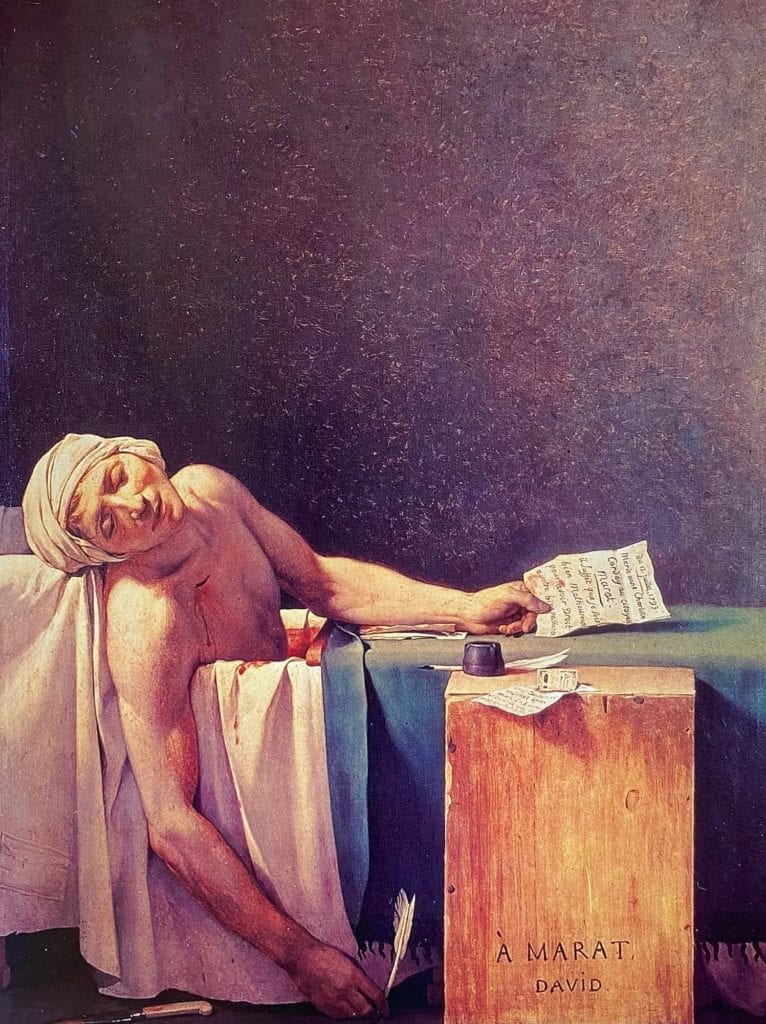Death of Marat by Jacques Louis David proves that Masterpieces have baggage too. This well-known piece speaks to us from the French Revolution. Unfortunately, it doesn’t speak the truth. Marat was a friend and ally to David. So, Jacques shone a light on their shared ideals in his death portrayal painting.
Click here for an audio version of this piece:
Yes, Marat was indeed murdered in his bath. Charlotte Corday killed him. But she had a reason. In her eyes, Marat was responsible for the death of Charlotte’s sister. Of course, that doesn’t make it morally correct. It simply points out that Marat was no martyr. With Death of Marat, David shows Marat in agony. He’s got perfect skin and seems to die an innocent, gentle man in his bath. It’s an understatement to say this portrait lacks veracity. Marat suffered from a horrendous skin condition. So bad, in fact, that he was unable to work as a doctor anymore. It made him look monstrous.
The man was also no innocent. He was a Jacobin and thus encouraged the Reign of Terror’s worst aspects. Marat was loud about it. The French Revolution held its share of vicious characters like this. But Marat and David remain two of the most notorious. No amount of David’s painted propaganda can change the truth of that history.
Death of Marat – Great Art Anyway
When it comes to a masterpiece, art lovers put morality to the side. Otherwise, they can’t appreciate great art. As an exercise in seeing, art works upon us without our constructed ideals. It opens us to other ways of looking. If you walk into a museum with a preconceived set of judgements about artists, you may miss out on the best stuff.
Take Jacques Louis David’s Death of Marat. It’s an exquisite painting. Even the background. At first glance it may seem plain. But it’s a strategic melding of gold and black speckling. The darkest black parts point to Marat’s death. The death of his voice signified with the darkest black by his hand clutching the plume pen.
His physical death’s a deep black triangle at his torso, where Corday stabbed Marat. The gold shines upon his outstretched hand like a light from above. It’s where he points his latest writing. Thus, Marat’s message seems to head toward life-after-death. This doesn’t come close to the most honorific aspect of the work. David saves that for the figure himself.
He portrays a martyr in Death of Marat. The anguish on his face shows that he finished this writing despite horrific pain. In fact, Marat still clutches a writing quill even in death. It’s as if his work matters more than his life. His shrouded head seems to show piety and humility. It’s a masterwork in manipulating the mind’s eye. We can’t help but see this as a painting of a humble hero. Never mind that the man it claims to portray was anything but.
Jacques Louis David – Factoids
- French painter Jacques Louis David (1748-1825), painted to great acclaim.
- Close buddy to Maximilien Robespierre, he was dictator of the arts under the French Republic.
- Jacques was also a loyal ally of the notorious Napolean.
- In fact, wielding great influence was kind of his thing. David’s considered the most influential French painter of his time.
- On the bright side, that meant the sweet and often sentimental Rococo style fell out of favor. He was far more realistic.
- Napolean said, “David, I salute you,” after seeing the coronation painting Jacques Louis did for him.
- He’s buried in Brussels but many claim his heart lies in the grave of his wife at Père Lachaise Cemetery, Paris.
ENJOYED THIS Death of Marat ANALYSIS?
Check out these other essays on French Painters.
